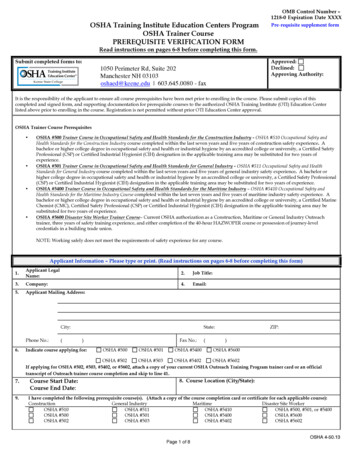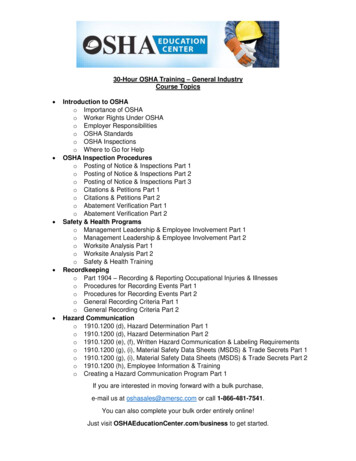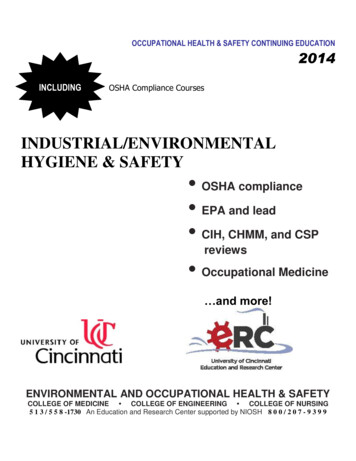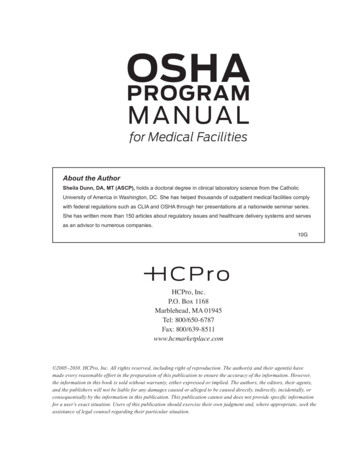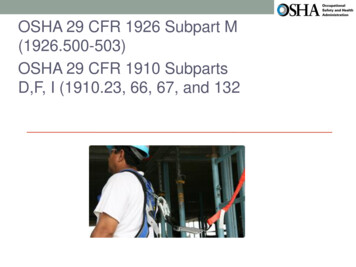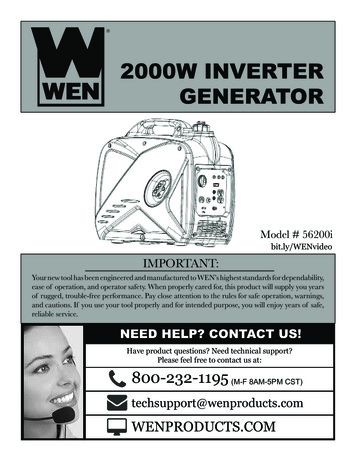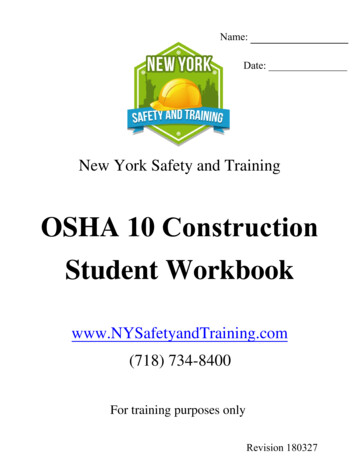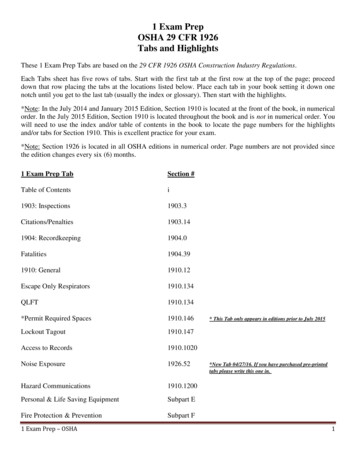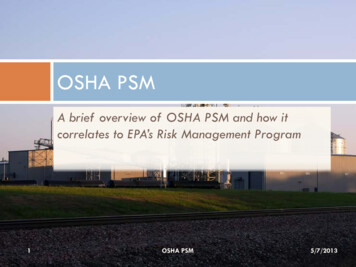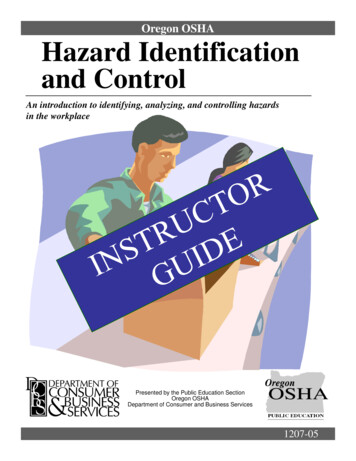
Transcription
This material is for training use onlyOregon OSHAHazard Identificationand ControlAn introduction to identifying, analyzing, and controlling hazardsin the workplacePresented by the Public Education SectionOregon OSHADepartment of Consumer and Business ServicesHazard Identification and Control1207-0559
Oregon OSHA Public Education Mission:We provide knowledge and tools to advanceself-sufficiency in workplace safety and healthConsultative Services: Offers no-cost on-site assistance to help Oregon employers recognizeand correct safety and health problemsEnforcement: Inspects places of employment for occupational safety and health ruleviolations and investigates complaints and accidentsPublic Education and Conferences: Presents educational opportunities to employers and employees on avariety of safety and health topics throughout the stateStandards and Technical Resources: Develops, interprets, and provides technical advice on safety and healthstandards Publishes booklets, pamphlets, and other materials to assist in theimplementation of safety and health rulesQuestions?Call usField em Central Office:Toll Free number in English: 800-922-2689Toll Free number in Spanish: 800-843-8086Web site: 541-776-6030541-388-6066541-276-2353
Information about this instructor guide and notes:This guide and notes workbook is set up so that a copy of the workbook page isshown in the order that it appears in the workbook. You are HIGHLY encouraged toread the entire instructor manual, add your personalized notations of examples,additional information you might want to add, alternative ways you may want topresent the material, etc.You will also find it helpful to attend an OR-OSHA class on this topic offered by theOR-OSHA public education instructors. Another good preparation strategy is tocomplete (or at least download) OR-OSHA online courses.Feel free to be creative in your presentations and personalize the material so that itfits your presentation style and preferences. Variety in your methods of presentationwill improve learner attention and retention. Try not to use the same format for morethan a 20 minute timeframe without changing to something at least slightly different.For example, lecture for 20 minutes, then have the class do an activity, then havefacilitated group discussion, etc., etc.Do not use these notes as your presentation outline to the extent that you are trying topresent this material exactly the way you think the developer would. It will appearunnatural and rote unless you customize the presentation to fit YOU.You are also encouraged to offer an opportunity for the class to critique yourpresentation either by using the evaluation sheet in the workbook, or some othermethod. Analyzing what people have to say about how the class went is your mostvaluable tool in helping you develop as a trainer. You are encouraged to provide uswith your feedback on how these materials could be improved and let us know if youfound them helpful.Your efforts in helping your company develop self-sufficiency and internal resourcesin the important area of staff training are much appreciated.
This material is for training use onlyWelcome !Every year over 6,000 Americans die from workplace injuries. An estimated 50,000people die from illnesses caused by workplace chemical exposures and 6,000,000people suffer non-fatal workplace injuries. Injuries, alone cost the economy more than 110,000,000 a year.Identifying and controlling workplace hazards involves many processes. It’s more thansimply “inspecting out hazards.” Before we can effectively control hazardousconditions and unsafe behaviors, we need to be familiar with their characteristics andthe necessary processes to make sure they are promptly identified and analyzed. Thequestions and exercises in this workshop will help us become more familiar withhazard control concepts and we’ll discuss the many types of hazards that may exist inthe workplace. We’ll discuss the various elements of an effective hazard controlprogram, the nature of hazards in the workplace, and finally we’ll put everythingwe’ve learned together in a final exercise.The purpose of this workshop is to give you the basic knowledge and skills to identify,analyze, and apply control strategies to eliminate or reduce hazardous conditions andunsafe practices in the workplace.Workshop goals: Explore the elements of an effective hazard identification and control program. Discuss the steps in the hazard identification and control process. Complete the hazard identification and control worksheet.IntroductionsHousekeepingForm TeamsPlease Note: This material, or any other material used to inform employers of compliance requirements of Oregon OSHA standards through simplification ofthe regulations should not be considered a substitute for any provisions of the Oregon Safe Employment Act or for any standards issued by Oregon OSHA. Theinformation in this workbook is intended for classroom use only.Hazard Identification and Control1
This material is for training use onlyWhat's inside?Identifying HazardsWhy is this workshop important?What do the rules for employers say?What do the rules for safety committees say?356What is a hazard?What is exposure?What you see are merely the surface symptoms778Types of Hazards in the WorkplaceHazards Cause Accidents: The Final EffectFour Strategies to Identify and Analyze Hazards1 - The Safety Inspection and Audit9151616Sample Safety Inspection Checklist2 - Observation3 - The Job Hazard Analysis (JHA)4 - The Incident/Accident Analysis17181920Exercise: What's wrong with these pictures?21Controlling HazardsThe Hierarchy of Controls1 – Engineering Controls2 – Management ControlsEffective Maintenance22232425Hazard Tracking ProceduresExercise: Using the Hazard Analysis WorksheetHazard Analysis WorksheetLet's Review!References2526283133Hazard Identification and Control2
This material is for training use onlyWhy is this workshop important?Use these to emphasize theimportance of identifyinghazards.Let’s take a look at some fatal accident reports from CDC*FATAL. The employee was working on a truss section while standing ina basket platform attached to the front of a forklift. While the forklift wasstationary, the basket was raised to approximately 14 feet above thepavement to allow the employee to work on upper sections of the truss.An additional part was needed to complete the assembly process, so theforklift operator moved the vehicle to where the additional part waslocated, with the employee still on the platform. The forklift had traveledseveral feet when the operator attempted to make a sharp left turn, which caused the forklift to losestability and roll onto its side. The employee was slammed to the pavement in the basket platform andreceived severe head injuries. The employee died in a hospital, several days later.FATAL: At the time of the accident, the victim, a laborer for a sand androck company, was repairing a split-rim tire to be mounted on a dumptruck. He had just completed patching the 22.5 inch tubeless tire andplaced a tube in the tire. He had mounted it on a 20 inch split-rimwheel. The victim was working on the ground outside of the protectivecage. The air chuck configuration provided by the employer put thevictim in the blast zone. As the victim attempted to inflate the tire theinnertube exploded, causing the tire assembly to strike the victim in the head. The sound of the explosionbrought other employees rushing to the scene. The victim was airlifted by Life Flight to the Oregon HealthSciences University Hospital where he died several days later of injuries related to this accident.FATAL. The son of the owner of a commercial drywallconstruction company, an employee of the company, wasreadying an aerial lift (Strato-Lift) for a job. The man hadreplaced two battery terminals. He had placed the aerial boomin the lifted position and was reaching toward the batterycompartment across the metal enclosure that houses the lift’stoggle controls when the boom descended and pinned him tothe control-panel area of the machine. The victim wasdiscovered by his father. Emergency medical services weresummoned, but they found the victim dead.*More fatal accident reports may be obtained at stateHazard Identification and Control3
This material is for training use onlyINJURY: A worker was applying grease to spreaderrollers with his gloved hands. He had turned on themachine to grease the moving parts. The spreaderrollers, which are about a quarter-inch apart, caughthis right hand glove and pulled his hand into therollers up to his wrist. The worker was able to stopthe rollers by striking the emergency bar above therollers, but his right hand remained caught betweenthe rollers. He yelled for nearby workers, who calledrescue personnel. The victim’s hand was notextricated from the rollers for 40 minutes. Themaintenance supervisor assisted fire departmentresponders by cutting loose the rollers that held thevictim. He was taken to a hospital for treatment,which included surgery.Fatal/Injury: On September 24, 1996, 53-year-old male elevator construction foreman (the victim) waskilled and his helper, an elevator constructor (employed by another subcontractor) was injured, when thehydraulic elevator car they were working under fell on them. The two were adjusting the hydrauliccylinder when the car fell, trapping them in the elevator pit. Two wooden poles (4x4 by approximatelytwelve-feet long ) used to keep the elevator from falling were placed leaning against the guide rails. Thecar was approximately fifteen inches above the poles, which they did not tie in place. The poles wereknocked out of position when the car fell due to the sudden loss of hydraulic pressure and trapped thetwo workers under the car. The elevator apparently did not fall evenly to the bottom of the pit. Thispermitted the rescue team to enter the pit area and extract the injured. However, rescuers had to use airbags to help raise the car to remove the victim.FATAL. While in the process of moving an aerial lift bucket intoposition, an insulated secondary service line became entangledbetween the outer edge of the bucket and the hydraulic toolcircuit manifold. The insulation on the service line wasdamaged, resulting in electrical arcing. A hydraulic tool circuitfitting was burned through, which allowed hydraulic fluid toescape and ignite. Fire immediately engulfed the bucket,resulting in second- and third-degree burns to the operator's body,plus lung damage due to smoke inhalation.Hazard Identification and Control4
This material is for training use onlyIDENTIFYING HAZARDSHazard Exposure AccidentWhat do the rules for employers say?Briefly discuss the rules.ORS 654.010 Employers to furnish safe place of employment.Every employer shall furnish employment and a place of employment which are safe and healthful for employeestherein, and shall do every other thing reasonably necessary to protect the life, safety and health of suchemployees.OAR 437, Div 001, Rule 0760 (7) Inspections.(a) All places of employment shall be inspected by a qualified person or persons as often as the type ofoperation or the character of the equipment requires. Defective equipment or unsafe conditions found bythese inspections shall be replaced or repaired or remedied promptly.(b) Wherever required in this safety code, a written and dated report, signed by the person or personsmaking the inspection, shall be kept.What does "qualified" mean?Theperson needs to have adequate knowledge and skills to detect and correct hazards.Whoever inspects needs to be properly trained and have experience.What criteria should we use to determine the frequency of inspections?The more change occurs and the more dangerous the hazards, the more frequent theinspections. The greater the risk (probability and severity of injury) the higher thefrequency.What does "remedied promptly" mean?From the time the employer knows a hazard exists, the employer is to put into action astrategyfor reducing or eliminating the hazard. Do not delay if feasible.What does your inspection report look like?If you found lots of hazards, it means the daily, weekly, monthly safety isn’t beingperformed adequately by line employees, supervisors, etc.Hazard Identification and Control5
This material is for training use only(8) In addition to the above requirements, your safety committee must:What do the rules for safety committees say?OAR 437, Div 001, Rule 0765 (7) Hazard assessment and control.(7) Your safety committee must establish procedures for conducting workplace safety andhealth inspections. Persons trained in hazard identification must conduct inspections asfollows:(8) In addition to the above requirements, your safety committee must: Work with management to establish, amend or adopt accident investigation procedures thatwill identify and correct hazards. Have a system that allows employees an opportunity to report hazards and safety and healthrelated suggestions. Establish procedures for reviewing inspection reports and for making recommendations tomanagement. Evaluate all accident and incident investigations and make recommendations for ways toprevent similar events from occurring. Make safety committee meeting minutes available for all employees to review. Evaluate management’s accountability system for safety and health, and recommendimprovements. Examples include use of incentives, discipline, and evaluating success incontrolling safety and health hazards.The safety committee is required to:EvaluateEstablishInspectRecommendSafety is freedom from danger, risks, or accidents that may result in injury, death, or property damage.Hazard Identification and Control6
This material is for training use onlyIt takes a hazard and exposure to produce an accident.What is a hazard?conditionpracticeAn unsafe or that could causeinjuryillnessanor toan employee.Can a person be a “walking" hazardous condition?By being distracted in any way. The truth is a person only makes thesituation worse by being distracted, tired, ill, intoxicated. Focus oncorrecting the hazard.What is exposure?When someone is within the “danger zone.” Physical exposure. When the person is generally within arm’s length. Environmental exposure. Due to noise, hazardous atmospheres, temperatureextremes. These hazards could affect everyone in the facility.How does your perception about the severity of ahazard change with daily exposure to that hazard?The more we’re exposed to a hazard without getting hurt,the more we trivialize the hazard.Which one of thoseincidents will end upas a serious injury?1MajorInjury29MinorInjuries300Near MissIncidentsH.W. Heinrich's Pyramid (1931)Hazard Identification and Control7
This material is for training use onlyWhat you see are merely the surface symptomsHazardous conditions and unsafe or inappropriate behaviors you see in the workplace arethe observable symptoms or effects of deeper system root causes.Surface symptoms: Are unique conditions or individual behaviors (you can point at a person or object)May exist or be performed by anyone, anytime, anywhereMay directly cause or contribute to an incident or accidentMay be important clues revealing root causesWhere do injuries come from?2Unpreventable acts. Only % of all workplace accidents are thought to beunpreventable. Heart attacks and other events that could not have been known by theemployer are examples of unpreventable acts. Companies often try to place most of theirinjuries into this category. They justify these beliefs with such comments as: "He justlifted the box wrong and strained his back. What could we do?" Unfortunately, they areexcuses for not looking into the "root cause" of the injury.What procedures do we use to detect and correct hazardous conditions?Inspection, observation, job hazard analysis, incident/accident analysis98System failure. Safety management system failures account for at least %of all workplace accidents. System failures refer to inadequate design or performance ofsafety programs that provide training, resources, enforcement, and supervision.Hazard Identification and Control8
This material is for training use onlyTypes of Hazards in the Workplace1. Falls. Lt. Chissov fell 22,000 feet and survived. Others who were not so lucky havedied falling on a slippery floor. It's not how far you fall, it's how you land! The mostcommon types of accidents are falls to the same surface, and falls to below. Theseverity of injury from a fall depends on three factors:1. velocity of an initial impact2. magnitude of deceleration – due to hardness of the surface3. orientation of the body on impactBriefly cover each hazard type and ask for examples inExamples:participants’ workplaces.2. Impact. Impacts resulting in struck by and struck against may cause seriousaccidents. The severity of injury from impacting objects depends on three factors:1. velocity of the impact2. characteristics of the object (size, hardness, shape etc.)3. body part impactedExamples:3. Mechanical. If it's mechanical, and it moves, it's a hazard. There are as manyhazards created by moving machine parts as there are types of machines. Mechanicalhazards cause caught-in, caught-on, and crush accidents that can cut, crush, amputate,break bones, strain muscles, and even cause asphyxiation.Mechanical Hazard Motions1. Rotating2. Reciprocating3. TransverseMechanical Hazard Actions1. Cutting2. Shearing3. Bending4. PunchingExamples:Hazard Identification and Control9
This material is for training use only4. Vibration and Noise. Tools, equipment, and machinery that vibrate at a lowfrequency can injury a part of the body or the whole body. However, the most commonsound-induced injury is due to high frequency vibration. Low frequency vibrationhazards exist in two primary categories:1. Segmental Vibration. Exposure to equipment that vibrates at various frequenciescan affect different parts of the body. For instance, the hands are most sensitive tovibrations at 30-40 cycles per second. Internal organs can be affected by at vibrationsas low as 4-10 cycles per second.2. Whole-Body Vibration. Very low frequencies can affect the entire body. Forinstance, truck drivers experience continuous whole-body vibration as they travel.That's one reason truck driving is considered one of the most hazardous tasks forlower back injuries.Briefly cover each hazard type and ask for examples inExamples:participants’ workplaces.5. Toxics. Virtually all materials may be toxic to some extent. In the workplace, amaterial is toxic if a small quantity can cause an injurious effect, such as tissue damage,cancer, mutations. It's important to consider the routes of entry of toxic materials intothe human body. There are four possible routes of entry:1. Inhalation. Breathing in toxics is the most common and dangerous route.2. Ingestion. Toxics enter through the gastrointestinal tract.3. Absorption. Toxics pass through skin into the bloodstream.4. Injection. Toxics may be injected into the body (needles, etc). The least common, yetmost direct route of entry.Examples:Hazard Identification and Control10
This material is for training use only6. Heat and Temperature. Overexposure to heat and temperature extremes mayresult in a range of injuries from burns to frostbite. Temperature indicates the level ofheat present. The second law of thermodynamics states that heat will flow from an areaof higher temperature to one of lower temperature. Heat is produced as a result of ;chemical reaction, combustion, electrical current, mechanical motion and metabolism.Heat is transferred by:Convection. Heat is transferred by molecules moving through a fluid, gas or liquid.Radiation. Occurs when a body's temperature is above absolute zero.Conduction. Heat is transferred through a substance or between substances withoutphysical movement of the substances itself.Examples:Briefly cover each hazard type and ask for examples inparticipants’ workplaces.7. Flammability/Fire. Fire may cause burn injuries. In order for combustion to takeplace, the fuel and oxidizer (oxygen) must be present in gaseous form. Flammablematerials swood/papercleaning oatingshydraulic fluidrubber productsExamples:8. Explosives. The results of an explosion may range from minor injury to majorcatastrophe (Space Shuttle Challenger). Instantaneous release of gas, heat, noise, lightand over-pressure creates a wave front that damages anything in its path. About 2 billionpounds of explosives are used by industry annually in construction, mining, quarrying,and seismographic work. Many types of explosions may ples:Hazard Identification and Control11
This material is for training use only9. Pressure Hazards. High and low pressure conditions in the workplace can resultin injury. Standard atmospheric pressure is 14.7 pounds per square inch (psi). Highpressure gas distribution lines are considered high-pressure when operating at 2 psi orhigher. The American Society of Mechanical Engineers (ASME) rate boilers whichoperate at more than 15 psi as high-pressure. The pressure in full cylinders ofcompressed air, oxygen, or carbon dioxide are over 2000 psi! Examples of pressurehazards include:Ruptured cylinders. The thrust generated by gas flowing through a puncture or ruptureof a cylinder can be 20 times greater than the weight of the cylinder and reach velocity of50 feet per second in 1/10th of a second! The result: a missile.Whipping hoses and lines. Compressed air and water hoses can kill when end fittingsbecome loose. Such hoses and lines should be restrained by weighting with sand bags atshort intervals, chained, clamped, etc. Never try to grab a whipping hose or line: turn offthe controlling valve.Water hammer. The effect caused by a sudden stop of liquid flow causing a shock wave(water hammer) that can cause a line rupture. Have you ever heard a pipe "clang"?Using compressed air for cleaning toolsCompressed air used for cleaning. Compressed air shall not be used for cleaningpurposes except where reduced to less than 30 psi. and then only with effective chipguarding and personal protective equipment. (29 CFR 1910.242(b))Employers should not allow employees to use compressed air for cleaningthemselves or their clothing. Why?Air may be injected under the skin causing a possible embolism. Fabric may alsobecome super-saturated with oxygen creating a serious fire hazard. Clothing can betotally engulfed in flame in an instant.Hazard Identification and Control12
This material is for training use only10. Electrical contact. Exposure to electrical current may cause injury or death. Thevoltage is not so important as the amount of current. It doesn't take much current to kill.There are five principle categories of electrical hazards:Shock. Electrical shock is a sudden and accidental stimulation of the body's nervoussystem by an electrical current. Look for bare conductors, insulation failures, buildup ofstatic electricity, and faulty electrical equipment.Ignition of combustible (or explosive) material. Ignition is usually caused by a spark,arc, or corona effect (ionized gas allows a current between conductors).Overheating. High current creates high heat that can result in fires, equipment burnoutand burns to employees.Electrical explosions. Rapid overheating of circuit breakers, transformers, and otherequipment may result in an explosion.Inadvertent activation of equipment. Unexpected startup of equipment and machinerycan injure and kill. That's why we have lockout/tagout procedures.Examples:Briefly cover each hazard type and ask for examples inparticipants’ workplaces.11. Ergonomics. Improper lifting, lowering, pushing, pulling, and twisting can causestrains and sprains. Ergonomics-related hazards are the most common source of injury inthe workplace. About 45% of all claims are related to ergonomics! Ergonomics hazardsexist in:The worker – physical/mental capability, preexisting conditions, etc.The task – work that includes high force, repetition, frequency and duration, andinappropriate posture, point of operation.The environment – noise, temperature, humidity, color, etc.Examples:Hazard Identification and Control13
This material is for training use only12. Biohazards. Exposure to plants, animals or their products that may be infectious,toxic or allergenic may cause illness and disease. People who work with animals, animalproducts or animal wasted have a greater risk of infection. Biohazard agents include:Bacteria – simple, one-celled organisms that may or may not be harmful.Viruses – organisms that depend on a host cell for development and reproduction.Fungi – may be small or large (mushroom) parasitic organisms growing in a living ordead plant or animal matter.Rickettsia – rod-shaped microorganisms that are smaller than bacteria and depend on ahost for development and reproduction. Microorganisms Transmitted by fleas, ticks andlice.Examples: Briefly cover each hazard type and ask for examples inparticipants’ workplaces.13. Workplace Violence. Workplace violence is any violent act that occurs in theworkplace and creates a hostile work environment that affects employees’ physical orpsychological well-being. A risk factor is a condition or circumstance that may increasethe likelihood of violence occurring in a particular setting. Risk factors include: Employee contact with the public Exchanging money Selling/dispensing alcohol or drugs Delivering passengers, goods or services Mobile workplace (such as a taxicab or police cruiser) Exposure to unstable or volatile persons (such as in health care, social services) Employees working alone, late at night/early morning, or in small numbers Employees working in high-crime areas Employees guarding valuable property or possessions Employees working in community settings Employees deciding on benefits, or in some other way controlling a person'sfuture, well-being, or freedom (such as a government agency)Examples:Hazard Identification and Control14
This material is for training use onlyHazards Cause Accidents: The Final EffectBriefly cover each accident type and ask for examples in participants’ workplaces.Struck-by. A person is forcefully struck by an object. The force of contact isprovided by the object.Struck-against. A person forcefully strikes an object. The person provides the forceor energy.Contact-by. Contact by a substance or material that, by its very nature, is harmfuland causes injury.Contact-with. A person comes in contact with a harmful substance or material. Theperson initiates the contact.Caught-on. A person or part of his/her clothing or equipment is caught on an objectthat is either moving or stationary.Caught-in. A person or part of him/her is trapped, or otherwise caught in an openingor enclosure.Caught-between. A person is crushed, pinched or otherwise caught between amoving and a stationary object, or between two moving objects.Fall-To-surface. A person slips or trips and falls to the surface he/she is standing orwalking on. A "top-ten" cause of injury.Fall-To-below. A person slips or trips and falls to a level below the one he/she waswalking or standing on.Over-exertion. A person over-extends or strains himself/herself while performingwork. A "top-ten" cause of injury.Bodily reaction. Caused solely from stress imposed by free movement of the body.Sudden motions, bends, slips, trips, without falling. A common cause of injury.Over-exposure. Over a period of time, a person is exposed to harmful energy(noise, heat), lack of energy (cold), or substances (toxic chemicals/atmospheres).Hazard Identification and Control15
This material is for training use onlyFour Strategies to Identify and Analyze Hazards1. The Safety Inspection and AuditRegular safety inspections and occasional audits are important in making sure theworkplace remains free of hazards that could cause injury or illness. The inspection examines conditions in the workplace to identify hazards. This iswhat the safety committee typically performs each quarter. The audit evaluates the quality of program design and performance to bettercontrol hazards. This is what the safety committee needs to perform to ensurecontinuous improvement. We'll discuss this strategy in the Controlling Hazardssection.How to develop an effective inspection checklist1. Determine applicable state safety & health rules for the workplace. Call theOR-OSHA technical services section (800) 922-2689 when you have questionsabout OR-OSHA rules. Also see our website: http://www.orosha.org.2. Review OR-OSHA rules and use those that apply to your workplace. Becomefamiliar with the rules that, if violated, would result in serious physical harm orfatality. Write questions that address hazards in OR-OSHA rules and serioushazards not covered by rules, if present. Guard against “tunnel vision. ”Who’s involved in the inspection process where you work?Everyone should be involved.How can you make the inspection process effective and useful?By making sure adequate observation is conducted. Super-vision! Get employeesinvolved by asking for input. Don’t focus on a condition look beyond and see why thecondition exists.Hazard Identification and Control16
This material is for training use onlySample Safety Inspection ChecklistYes No NABriefly discuss this sample checklistFLAMMABLE & COMBUSTIBLE MATERIALS CHECKLIST1. Are combustible debris and waste materials stored in covered metal receptacles andremoved from the work environment?2. Are proper storage methods used to minimize the risk of fire and spont
4 - The Incident/Accident Analysis 20 Exercise: What's wrong with these pictures? 21 Controlling Hazards The Hierarchy of Controls 22 1 – Engineering Controls 23 2 – Management Controls 24 Effective Maintenance 25 Hazard Tracking Procedures 25 Exercise: Using the Hazard Analysis Worksheet 26 Hazard
